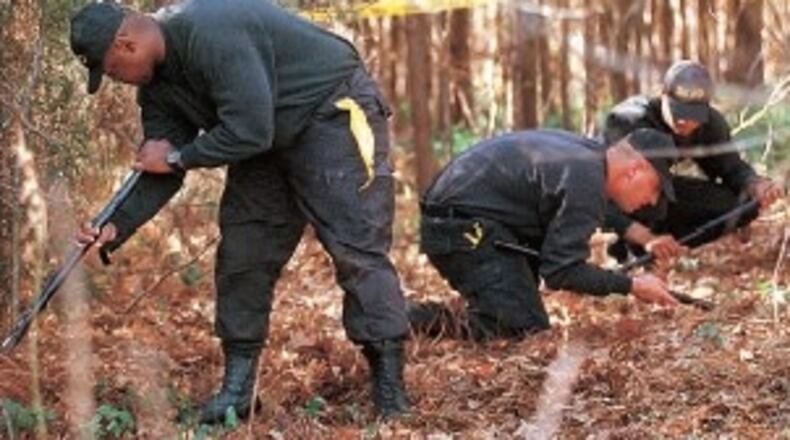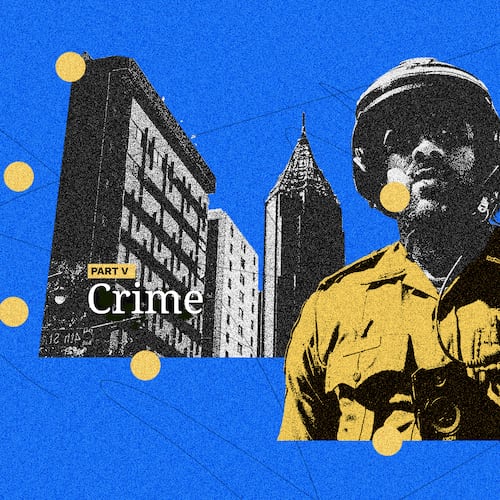When a cemetery worker found the remains of a 6-year-old boy near a DeKalb County cemetery in 1999, his identify was a mystery that wasn’t solved until this week, when officials announced murder charges against Teresa Ann Bailey Black, now 45, the mother of William DaShawn Hamilton.
UPDATE: ‘Give this child justice.’ Cold case murder trial starts in DeKalb
William was found Feb. 26, 1999, in a wooded area near Clifton United Methodist Church in South DeKalb County.
The Atlanta Journal-Constitution covered the case in a front page story published March 2, 1999, as police asked the public for help in identifying the child. A second story published later in the month by reporter R. Robin McDonald, included a forensic artist’s clay rendering of the the child’s face, created at the request of investigators in hopes that someone who saw the image might recognize him.
McDonald’s story noted plans to hold a memorial service for the child at nearby Clifton United Methodist Church.
Sixteen years later, columnist Gracie Bonds Staples wrote about the then-cold case, with the headline, Identification of dead child haunts DeKalb Medical Examiner’s Office. Investigators had taken to calling the child “Dennis,” she wrote, because they didn’t know his name. The National Center for Missing & Exploited Children was trying in 2015 to bring new attention to the case.
“It is estimated that there are 40,000 unidentified human remains in this country. Forty thousand people for whom it would seem no one cared whether they lived or died,” Staples wrote. “Of those, about 650 are children, said Robert Lowery, vice president of the National Center for Missing & Exploited Children’s missing children’s division. Dennis is the only unidentified kid in DeKalb County. There are 14 in Georgia.”
Footnote: On Wednesday, the center announced on its home page that William had been identified.
Where the child’s body was found in 1999
Here is the full text the March 17, 1999 story from The Atlanta Journal-Constitution
The search for victim’s name
By R. Robin McDonald, The Atlanta Journal-Constitution
Watching the face of a dead child emerge from clay is as haunting as the memory of a once-forgotten tune.
It is as if the spirit of the small boy with his wide, uneven smile and baby teeth giving way to adult molars has slipped through death’s back gate with clues as to who he was, what happened to him, and who may have left him dead or dying in a stand of pines below an old DeKalb County cemetery.
Harvey Pratt calls forth such faces from the dead.
An artist and a criminal investigator with the Oklahoma Bureau of Investigation, he has been doing so for nearly 20 years.
On Tuesday, Pratt was at the DeKalb County Medical Examiner’s office, patiently reconstructing the face of a child whose skeletal remains were found by a gravedigger Feb. 26.
The child’s body had been lying in the woods between three and six months when it was found. The boy was between 5 and 7 years old when he died. A forensic anthropologist used scientifically accepted skeletal measurements to determine that the child was black. DNA extracted from muscle tissue confirmed his sex.
But in the three weeks since the body was found, DeKalb investigators say, no one has stepped forward to identify him.
Now, they hope that Pratt’s three-dimensional reconstruction of the boy may prod someone into recognizing him and calling authorities with his name.
Once they know who he is, investigators say, they have a good chance of finding out what happened to him and how he came to die.
Credit: AJC
Credit: AJC
So far, only the boy’s nearly new, size 11 brown Timberland boots has provided clues on where he is from. Investigators say those boots were first introduced in the Atlanta market in June 1998, months before they went on sale nationwide. Investigators say the child may have died as early as last August.
Tuesday morning, Pratt began his work with the boy’s skull. Using a set of measurement tables compiled by forensic anthropologists, his own artistic talent, a few simple tools, and his hands, Pratt molded the child’s face with sculptor’s clay that is the warm brown color of skin.
“It’s not an exact science,” he said. “We’re attempting to utilize an artistic ability with some scientific features based on what anthropologists tell us of age, weight, height, sex and race.”
“The markers on the skull tell us how thick the skin is of a person of a certain race, age and weight,” he said.
Lip placement is based on measurements from gum line to gum line. Sockets in the jaw determine how teeth are attached and aligned. Ear length is generally the same as that of the nose.
Once the tissue markers are in place, “you rely on what the skull tells you, and what you feel about it,” Pratt said. “I’ll use a little bit of artistic enhancement, but I’ll stay as true to those markers as I can.”
The investigator said he does every reconstruction “in a respectful way so that God will give us a little bit of assistance.”
“If you believe in a Creator,” he said, “you ask for His help, that He will have pity on us and help this little boy complete his journey.”
Credit: AJC
Credit: AJC
Pratt joined the Oklahoma Bureau of Investigation in 1972. He began doing two-dimensional reconstructions using techniques he acquired from photo airbrushing classes and from forensic anthropologists. Pratt said that since the early 1980s, he has completed more than 275 reconstructions of unidentified bodies, either as drawings or as three-dimensional sculptures. About 60 percent have led to confirmed identifications, he said.
Six hours after he began work Tuesday, Pratt attached the reconstructed skull to a small mannequin. Four feet tall, the mannequin is dressed in red jeans and a plaid, hooded shirt that matches the clothes the child was wearing. The small Timberland boots are on his feet. The boy is smiling a wide smile with distinctive, uneven teeth. He has begun losing his baby teeth.
“These are things that a mother would pay attention to,” Pratt said.
This marks the first time that either Pratt or DeKalb investigators have created a three-dimensional figure of an entire body. “It’s a little more dramatic,” he said. “It makes a person seem more whole.”
Lori Campbell, a lab supervisor at the DeKalb Medical Examiner’s office, made the clothes. At a flea market, she found a shirt of the same plaid material the child wore, investigators said.
She made the shirt’s hood and sleeves from long underwear that she dyed and the red jeans from matching material that she purchased.
The shirt and pants the boy was wearing have not been manufactured since 1995. Investigators say that could mean that the boy had an older brother or cousin and was wearing hand-me-downs.
Only the boots were nearly new. In June 1998, the boy’s Timberland boots were introduced in Atlanta as an experimental market, although they are now sold nationwide.
Investigators have identified three stores that sold the boots, one of them at South DeKalb Mall.
The boots and Pratt’s reconstruction of the child are investigators’ best hope of identifying the body.
“It’s about the best we can do for the little guy,” said Woody Hall, a forensic investigator with the DeKalb Medical Examiner’s office. “It’s his last little chance to speak out and get help.”
A memorial service for the child has been scheduled for Thursday at 3 p.m. at Clifton United Methodist Church, 2918 Clifton Church Road., near where the body was found.
Credit: AJC archives
Credit: AJC archives
Credit: AJC Print Archives
Credit: AJC Print Archives
About the Author
The Latest
Featured






